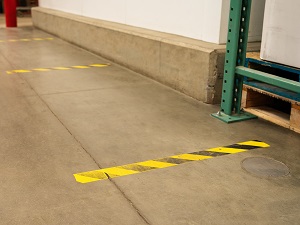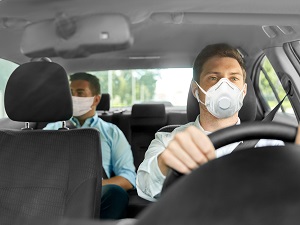Safety precautions to consider and safety tips that can help when employees may be required or advised to practice physical or social distancing measures at work to prevent or slow the transmission of airborne illnesses.

Social distancing, also called physical distancing, means to keep space between yourself and other people outside of your home.
To practice social distancing:
- avoid close contact with people who are sick.
- stay at least 6 feet away from others or stay separated by physical barriers.
- stay out of crowded places and avoid large gatherings.
- avoid crowding, or working closely together, while at work.
- limit the duration of close physical contact with others.
Small particles that people breathe out can contain virus particles. The closer you are to a greater number of people, the more likely you are to be exposed if someone nearby is infected.
To reduce the risk of transmission of infectious disease, employees may choose to continue social distancing practices while at work or in other public areas. Because the risk of severe illness is different for everyone, some workers may practice social distancing to protect themselves, or to protect a loved one.
In addition to basic health and hygiene practices, like handwashing, additional protective measures include vaccines, testing, improving ventilation, and wearing a face mask.

If you are unsure if you should continue social distancing or not, learning about how infectious diseases can spread and the factors that can increase or decrease that risk can help you make informed choices.
Longer exposure time increases the risk of transmission. For example, contact longer than 15 minutes is more likely to result in transmission than two minutes of contact.
Activities like coughing, singing, shouting, or breathing heavily due to exertion increase the risk of transmission.
Being around people who are symptomatic increases the risk of transmission.
If you are near someone who might be infected, wearing a mask can be helpful. If one person is wearing a mask, the risk of transmission is decreased, and if both people are wearing masks, the risk is substantially decreased.
Being outside is a lower exposure risk than being indoors, even with good ventilation and filtration.
Crowded settings can raise the likelihood of transmission because there is a greater chance that someone in the crowd is infected.

Social distancing helps limit opportunities to come in contact with contaminated surfaces and infected people outside the home or at work.
For workplaces that encourage social distancing, or employees who prefer social distancing to limit their exposure, any or all of the following recommendations may be helpful.
- Workers can maintain at least 6 feet of distance from others at all times, including when they are on breaks.
- Avoid congregating in restrooms, parking areas, locker rooms, near time clocks, in offices, and while eating or getting coffee.
- Keep frequently touched common surfaces clean, including telephones, desks, tools, work benches, and equipment.
- Limit unnecessary visitors.
- Instead of shaking hands, use a different noncontact method of greeting.
- Improve ventilation and filtration for indoor spaces.
- Use portable high-efficiency particulate air (HEPA) cleaners.
- Move indoor activities outdoors, when it’s feasible.
- Continue with good health and hygiene practices, like handwashing.

It may be preferred to host an online meeting instead of a large, in-person, group meeting. E-mail, teleconferencing, or videoconferencing can take the place of meetings or communications that may have previously been held in-person.
If in-person meetings are unavoidable, break them into smaller groups of people instead of holding a larger gathering. If possible, hold meetings in open, well-ventilated spaces to allow those who prefer to social distance the opportunity to do so.
Social distancing can be difficult in some situations.
If carpooling or using shared transportation to and from work, you may choose to wear a face mask while in the vehicle. Practice coughing and sneezing etiquette when traveling in a shared vehicle.
Wash your hands immediately upon arriving at work and always wash your hands after physical contact with anyone at work.

The best way to prevent illness is to avoid being exposed.
Handwashing is one of the best ways to protect yourself from getting sick. Wash your hands often with soap and water for at least 20 seconds. If soap and water are not readily available, use an alcohol-based hand sanitizer with at least 60% alcohol. Cover all surfaces of your hands and rub them together until they feel dry. Avoid touching your eyes, nose, and mouth with unwashed hands.
Sometimes it may not be practical for you to stay away from a person who is sick, or you may want to help take care of them. In those situations, use as many prevention strategies as you can, such as practicing hand hygiene, consistently and correctly wearing a high-quality mask, improving ventilation, and keeping your distance, when possible, from the person who is sick or infected.
Stay home if you are sick. Employees who appear to have symptoms including fever, cough, or shortness of breath should contact their supervisor and stay at home. Employees who begin to develop symptoms or feel ill during the course of the workday should separate themselves from the work environment immediately and contact their supervisor.

.jpeg)

.jpeg)